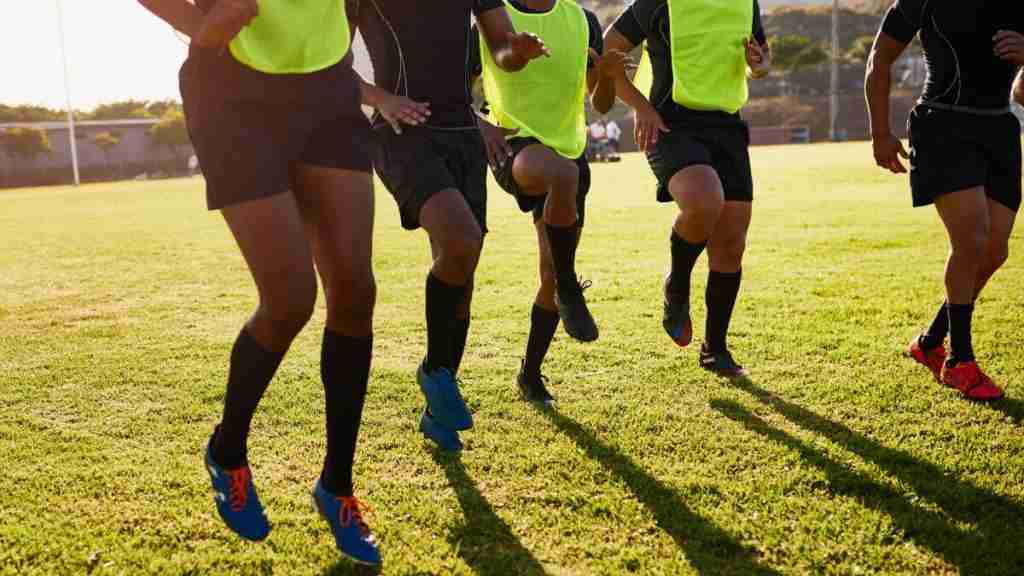One of runners’ most frequently asked questions is, “what does running do to your body.”
Starting to run will change your life (it changed mine). Running is not just a way to exercise; it teaches you how to be disciplined to get what you want. Running will contribute to shaping your body and your mind, helping you lose weight, and living a longer, healthier, and happier life.
Exercise can help you start your day in full force and instantly boost your mood, according to a group of researchers. They found evidence of a consistent positive relationship between physical activity and happiness.
Read on to discover all the amazing benefits of running. You can watch a summary of this article in this video.
See also: Here’s How To Motivate Yourself to Run Regularly
Check out a video summarizing this article we uploaded to our YouTube channel.
Table of Contents
So, What does Running do for Your Body Shape?
Running benefits for the body are enormous. It is an efficient weight-loss tool, especially when mixed with resistance training, as well as a means for improving muscle, bone, and joint strength.
In general, runners have a 25%-40% reduced risk of premature mortality from any cause and live approximately three years longer than non-runners, according to a study.
So it is no surprise that running is strongly associated with several benefits for our bodies and brains. A great way to get started on your journey as a runner is to join a supportive community of like-minded people
Let’s explore the 10 amazing health and mental benefits of running.
See also: 9 Amazing Tips On How To Start Running Again
1- Running Helps you Burn Belly Fat
As you exercise, you burn calories, and your body fat percentage diminishes. So, running not only helps you to reduce belly fat, but it also sheds fat from other areas.
Running torches a severe amount of calories. When you start running regularly, you start spending more energy regularly. If you keep your energy-in (total calories eaten) relatively the same, science says you’ll begin to lose fat.
As we creep into middle age, the fat that used to land on our hips and thighs primarily starts to show up along our belly increasingly; this is particularly true after menopause.
Contrary to fat in other body areas, this visceral fat, as it is known, can double your risk of chronic health issues such as diabetes and heart disease. It is stubborn, but frequent cardio sessions appear to diminish or erase it.
Duke University Medical Center observed that cardio workouts could lead to more belly fat loss than strength training exercises or a combo of strength training and cardio.
See also: 10 Best Abs Exercises That Really Work for Females at Home [With Videos]

2- Running Makes you Look Younger and Healthier
Running can keep your skin soft and glowing. Researchers at McMaster University in Ontario, Canada, analyzed a small group of adults between the ages of 20 and 84. The frequent exercisers over the age of 40 had skin that resembled the more supple, elastic skin compared to individuals in their 20s and 30s.
The research team reported that the difference had nothing to do with sun exposure, which would age your skin faster if you did not wear sunscreen.
They hypothesized that exercise creates body substances that help slow aging in the skin. They also indicated that more research is needed to learn how physical activity changes skin composition.
The American Academy of Dermatology suggests that modest exercise can enhance circulation and boost the immune system. Consequently, this may give the skin a more youthful appearance.
See also: Benefits of Exercise Bike Versus Treadmill – Which One Is Best for You?

3- Running Helps Relieve Menopause Symptoms
Menopause comes with many symptoms and transformations in body composition. Some of the changes include joint pain, reduced bone density, fatigue, mood swings, and self-worth problems, which are all too common. However, running can help you deal with at least part of these symptoms.
Exercise has promise for combating some menopause-related symptoms. A study reveals that physical activity positively affects your cardiovascular system and bones and improves overall fitness, muscle strength, and mobility. Running might also help women maintain healthy body weight.
Running might not relieve symptoms such as hot flashes. However, it can improve women’s overall well-being, improve their bone composition, enhance their sleep quality, help them battle fatigue, and make weight control significantly more manageable.
On a psychological level, menopause can come with particular concerns. Running can also help women manage their quality of life and a sense of self-worth.
Physical activity can have long-term benefits for women undergoing the menopausal transition, according to 2009 research.
See also: The Best Ten Teas For Weight Loss.

4- Contrary to What Many People Believe, Running Does not Hurt your Knees; it Actually Seems to Improve Knee Health
A lot of people worry that running might ruin their knees. However, a study finds that running may be beneficial to your joint, changing the biochemical conditions inside the knee in ways that could support keeping it working smoothly.
Another study found that running decreases knee intra-articular pro-inflammatory cytokine concentration.
Knee pain can quickly sideline you during your run. It is often a sign of overtraining or needing to change your form or flexibility. However, running probably is not the cause of knee osteoarthritis.
In a study of 2,637 participants, experts found that the more individuals ran, the less likely they were to endure knee pain or osteoarthritis. Similarly, it is difficult to believe that running directly caused people to experience less knee pain.
See also: 40 Fat Burning Exercises That Are Proven To Work – Backed by Science

5- Running Strengthen Bones
One of the benefits of running is that it helps strengthen your bones. The following studies support that running benefits your bones.
University of Missouri researchers have observed that high-impact activities, such as running, might significantly affect bone mineral density (BMD) more significantly than resistance training.
The National Osteoporosis Foundation recommends practicing high-impact weight-bearing exercises to build bones and maintain them strong. However, you may need to avoid high-impact activities if you have fractured a bone due to osteoporosis or are at risk of fracturing a bone.
Also, the National Institutes of Health recommends an optimal goal of at least 30 minutes of physical activity on most days, preferably daily.
See also: How Long Does it Take To Get Good at Running: 5 Things To Keep In Mind
6- Running Help you Lose or Maintain Weight
One of the most important parts about becoming a regular runner is that your body starts burning more calories for you. You know that exercising burns calories while you are working out. The bonus is that when you work out, the burn continues after you stop.
The American Council on Exercise published a chart suggesting that a 120-pound (54.5 Kg) individual loses about 11.4 calories per minute when running. Similarly, if that person runs a 10-minute mile, they will burn 114 calories.
If that individual weighs 180 pounds, the calorie burn goes up to 17 calories per minute. The 180-pound (81.7 Kg) runner would burn 170 calories running that same 10-minute mile.
| Your Weight | Calorie burn per minute |
| 120 lb / 54.5 kg | 11.4 |
| 140 lb / 63.51 kg | 13.2 |
| 180 lb / 81.7 kg | 17.0 |
Another study shows that running can be an efficient way of losing weight, considering it is combined with a diet change. Researchers concluded that an average running distance of more than 5 km per week combined with a proper diet is recommended to lose weight.
In other words, regularly running mixed with diet modification effectively reduces fat mass over one year among novice runners.
See also: 18 Veggies That Destroy Stomach Fat – Backed By Science.
7- Running Change Your Body and Help you Build Muscle
Your body’s most important muscles are all located in your legs, and running is beneficial to all of them. These muscles comprise your inner and outer thighs, gluteus maximus, quads, hamstrings, and calves. Running is like a dozen leg workouts in one.
When running, you utilize a particular set of muscles each time. These muscles include your core and low back (stabilizers), calves, quads, and hamstrings. As a result, these are the muscles where you will see the most change in strength and size.
Running does not always lead to an outstanding amount of muscle mass, but that doesn’t mean you can’t build muscles.
Research provides considerable proof to support that aerobic exercise training can produce skeletal muscle growth.
See also: 12 Best Tips On How To Love Running

8- Running works your core and Helps you Get Abs
There exist four kinds of abdominal muscles. First, we have the rectus abdominis, knowns as the 6-pack muscle. Also, we have the internal obliques (inner sides), external obliques (outer sides), and the transverse abdominis (the deepest of the four muscles which move around the abdominal area like a corset).
All four muscles need to be pushed to reach peak abdominal strength, and cardiovascular exercise is necessary on top of that to see the ultimate ab definition.
Dr. Karena Wu, an NYC physical therapist and owner of ActiveCare Physical Therapy, explains that during running, all four [kinds] are typically activated as your arm. Leg movement promotes some rotation (will fire the obliques), and the impact strength of running will fire the transverse abdominis and rectus abdominis to assist in stabilizing the lumbar spine and decrease compressive forces in the spine.
The lower body is not the only part of you that welcomes the benefits of running. It is also a core carver, stimulating your six-pack rectus abdominis and deeper core muscles, including your obliques, erector spinae, and transverse abdominis.
Those deep muscles stabilize your spine, shift strength between your swinging arms and legs, and suck in your gut.
See also: 32 Foods That Burn Belly Fat Fast – Based on Science

9- Running Prevents or Reduces Cancer Risk
Perhaps running does not cure cancer, but there is plenty of proof that it helps prevents it. Vast research of 170 epidemiological studies in the Journal of Nutrition revealed that regular exercise is linked with a lower risk of a particular type of cancer.
What is more, if you already have cancer, running (with your doctor’s permission) can enhance your quality of life while you undergo chemotherapy.
An article from Harvard Health Publishing / Harvard medical school supports the theory that regular exercise reduces the risk of many types of cancer.
See also: Here’s How to Set SMART Running Goals
10- Running is Good for Your Mind
Runners usually share their stories on how a good run can instantly improve their mood. That feeling called “runner’s high” is a euphoric sensation when your body starts producing endorphins as soon as you start pounding out some miles.
According to a study by the Journal of the American College of Sports Medicine, even spending 30 minutes on a treadmill is sufficient to lift the mood of someone suffering from a major depressive disorder. The study also found that even participants who moved at a slow walking pace received the same mood-lifting benefits.
Another article from Harvard Health Publishing / Harvard medical school reported that no matter what speed you are running, moving has positive effects on your body and helps fight depression.
Physical activity acts as an effective alternative to treating depression, found another study published in the Health and Fitness Journal.
Running can significantly promote physical and mental well-being. Considered a form of aerobic exercise, running can decrease stress, improve heart health, and even help alleviate symptoms of depression.
See also: Pros and Cons of Running for Weight Loss – Science-Backed Studies.

How Much do You Need to Run to Change Your Body?
It is well-known that aerobic activity is beneficial for your heart, so it is no surprise that running can improve cardiovascular fitness. Usually, the more people run, the healthier their hearts tend to be. However, you can get significant benefits without having to do a lot.
A study from the Journal of the American College of Cardiology found that running just five minutes daily might add years to your life.
Recent research issued in the American Journal of Clinical Nutrition showed that physical activity had been associated with reducing both the risk of diseases and mortality risk. Researchers have shown that if people exercised more, this change could reduce a considerable number of deaths worldwide—for instance, they have estimated that over half of all deaths from cancer might be prevented with regular exercise.
However, it is not very explicit how much physical activity we need. The general recommendations from the Centers for Disease Control and Prevention (CDC) are 150 minutes/per week of moderate exercise, but as mentioned, that part is still up for debate. Some researchers suggest we need more than this to reap the benefits, while others suggest that every little bit helps.
Also, there has been some worry about extreme amounts of running. For instance, running ultramarathon distances could stress or scar the heart. However, an increasing body of research appears to indicate that it is not something to worry about.
Researchers have discovered that a person who runs at least 40 miles per week has a healthier heart than an individual who runs 13 miles weekly.
See also: Does Running Burn Fat: Helpful Running for Weight Loss Tips For Beginner
It is Never Too Late to Start Running
So, what if you are beyond your twenties and have not started a regular running routine? Follow these simple tips to get started, whether overweight or out of shape.
You can still reap all the advantages of running, including beating the clock of aging, preventing heart failure, and generally staying healthy and fit.
See also: Here’s How to Start Running When Overweight and Out of Shape – 11 Simple Tips.
How to Start Running?
Are you wondering how to start running? If you are ready to improve your health, now is the time to do it. Start by setting some attainable goals with SMART Running Goals setting.
Imagine being in your 70s with the muscles of a 25-year-old. Will you regret it?
How to Increase All The Benefits You Get From Running?
Whether you are a beginner to running or an experienced runner, you have always asked yourself: “what does running do to your body?” and “how can you increase all the benefits you get from running?”
A beginner’s body takes some time to adjust and adapt to running. Like beginner runners, experienced runners reach a plateau, and their bodies become accustomed to the same distance, speed, and terrain. As a result, their body stops changing or starts to maintain the same level.
So, how can you increase all the benefits you get from running?
1- Track Your Heart Rate
Tracking your heart rate is one method to monitor fat and boost muscle building with running. When you are doing cardio or running, you want to stay in the range of 65% – 70% of your maximum heart rate. If the goal is to improve stamina and aerobic capacity, you aim for 85%.
To ensure you stay within this zone during your runs, use a simple fitness tracker. You might consider getting one for as low as $45 on Amazon, which tracks your steps, heart rate, and more.
See also: Best Fitness Tracker For Yoga And A Healthier Life.
Monitoring your run will keep you accountable for staying in this zone, allowing you to scorch fat and build muscle.
See also: Optimal Fat Burning Heart Rate For Weight Loss
2- Eat the Right Foods (And the Right Amount)
More importantly, you are required to be eating enough food. If you do not replace the calories that you burn while running, your muscles will not be able to grow.
Also, you need to start thinking of reducing your fat and boosting your protein. You can learn How to Eat Healthy for Beginners Runners.
See also: 32 Foods That Burn Belly Fat Fast – Based on Science.

Conclusion
Now that you have learned what running does to your body, it is time to get excited about running and start reaping all its fantastic benefits.
When you start running regularly, you will feel rejuvenated, lean, healthier, and more energetic.
What would you do now? Just start and motivate yourself to run regularly, and you will observe that running will slowly and positively change your body and mind.

